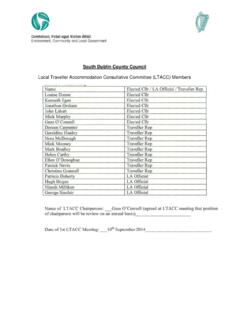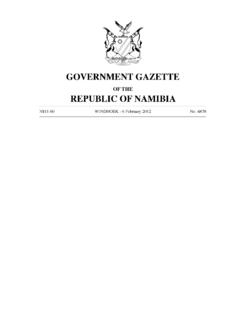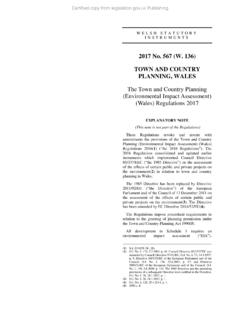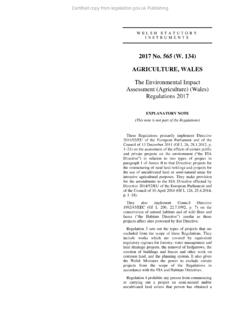Transcription of Environmental Impact Assessment - housing.gov.ie
1 Guidelines for Planning Authorities and An Bord Plean la on carrying out Environmental Impact Assessment August 2018 Prepared by the Department of Housing, Planning and Local Government 1 Contents Foreword by Mr Eoghan Murphy, , Minister for Housing, Planning and Local Government .. 3 1 Introduction .. 5 The Directive .. 5 The Guidelines .. 8 2 What is Environmental Impact Assessment ? .. 11 3 Pre-Application Stage .. 14 Screening .. 14 Scoping .. 20 4 Application Stage .. 24 The Environmental Impact Assessment Report .. 24 Non-Technical Summary .. 25 Competent experts .. 26 Reasonable Alternatives .. 27 Environmental Factors.
2 27 Human Health .. 27 Biodiversity .. 29 Land .. 30 Climate .. 31 Risk of major accidents and disasters .. 31 Baseline Scenario .. 32 5 Consultations and EIA Portal .. 33 Consultation with prescribed bodies .. 33 Informing and consulting the public electronically .. 33 EIA Portal and Competent Authority websites .. 34 6 The Assessment .. 37 Examination/ Assessment /Reasoned 37 Likely significant effects .. 38 Cumulative 40 7 The Decision .. 41 Monitoring Conditions .. 44 8 Outline of and guide to key sections of the Act .. 45 Appendix I - Codified Directive .. 51 Appendix II Text of Circular Letter PL 1/2017 .. 99 2 Appendix III Text of Circular letter PL 8/2017 as revised by Circular letter PL 5/2018.
3 106 Appendix IV - Glossary of Terms .. 117 3 Foreword by Mr Eoghan Murphy, , Minister for Housing, Planning and Local Government Environmental Impact Assessment (EIA) is an increasingly important element of European Union Environmental policy. The first EIA Directive was adopted in 1985 (Directive 85/337/EEC) and, following the adoption of amending Directives in 1997, 2003 and 2009, a codified Directive was adopted in 2011 (Directive 2011/92/EU). Directive 2014/52/EU amends the 2011 codified Directive but does not replace it. The EIA Directive requires that public and private projects that are likely to have significant effects on the environment be made subject to an Assessment prior to development consent being given.
4 Environmental Impact Assessment is a process to be undertaken in respect of applications for specified classes of development listed in the Directive before a decision in respect of development consent is made. The process involves the preparation of an Environmental Impact Assessment Report (EIAR) by the applicant, consultations with the public, relevant prescribed bodies and any other affected Member States, and an examination and analysis of the EIAR and other relevant information leading to a reasoned conclusion by the competent authority on the likely significant effects of the proposed development on the environment.
5 EIA does not, in itself, dictate the outcome of the development consent decision of the competent authority, but is an important and essential consideration in decision making procedures and the achievement of high quality, sustainable development. The provisions of the 2014 Directive are aimed at enhancing the EIA process through ensuring the completeness and quality of the EIARs submitted by the applicant and the examination undertaken by the competent authority and by providing for early and effective public participation before the development consent decision is made. The Directive requires the EIAR to be prepared by competent experts and for the competent authority to have, or have access to, the necessary expertise to examine 4 the EIAR and reach a reasoned conclusion in respect of the likely significant effects on the environment resulting from the proposed development.
6 In order to enhance the opportunity for effective public participation, the Directive requires early public notification of all EIA development consent applications and that easy access to the relevant application information be provided by electronic means as well as by the more traditional newspaper and site notices. In this regard, a central EIA Portal is now in operation. The Portal is managed by my Department and contains the necessary notification information as well as providing a direct link to the relevant competent authority s website and file number where the detailed information is published relating to an EIA application as it progresses through the consent process.
7 The Portal covers all EIA applications, marine and terrestrial, across all legislative codes, and is searchable in respect of the range of information it holds. It provides a simple to use gateway to all EIA applications. The publication of these Guidelines coincides with the making of the European Union (Planning and Development) ( Environmental Impact Assessment ) Regulations 2018 ( No. 296 of 2018) and the coming into operation of the Regulations on 1st September 2018 in order to transpose the Directive into Irish planning law. The Guidelines replace Guidelines for Planning Authorities and An Bord Plean la on carrying out Environmental Impact Assessment issued by the Department of the Environment, Community and Local Government in March 2013.
8 The purpose of the new Guidelines is to give practical guidance on procedural issues and the EIA process arising from the requirements of Directive 2014/52/EU and to assist with the achievement of a consistency of approach in the implementation of the Directive. Eoghan Murphy, Minister for Housing, Planning and Local Government 1 5 1 Introduction The Directive Environmental Impact Assessment (EIA) is a very significant and expanding instrument in the implementation of EU Environmental policy. Since the adoption of Directive 85/337/EEC (on 27th June 1985) on the Assessment of the effects of certain public and private projects on the environment, both the law and EIA practices have evolved significantly1.
9 The 1985 Directive was amended by Directives 97/11/EC, 2003/35/EC and 2009/31/EC, and the Directive and its amendments were codified in 2011 by Directive 2011/92/EU. The current Directive 2014/52/EU amends the 2011 codified Directive, but does not replace it. The full text of the codified Directive showing the 2014 Directive amendments is contained in Appendix 1 of these Guidelines. The objective of the Directive (Directive 2011/92/EU), as amended by Directive 2014/52/EU, is to ensure a high level of protection of the environment and human health, through the establishment of minimum requirements for Environmental Impact Assessment (EIA), prior to development consent being given, of public and private developments that are likely to have significant effects on the environment.
10 Planning authorities and An Bord Plean la have long experience in assessing the effects of a proposed development on the environment as this is an integral part of considering whether the proposal is in the interests of the proper planning and sustainable development of the area. The European Union (Planning and Development) ( Environmental Impact Assessment ) Regulations 2018 ( No. 296 of 2018) transpose the requirements of the 2014 EIA Directive into existing planning consent procedures. Footnotes are provided throughout these Guidelines. References to provisions of the Planning and Development Acts 2000-2018 and the Planning and Development Regulations 2001-2018 are, where appropriate, references to the Acts and Regulations as amended by the transposing Regulations.











